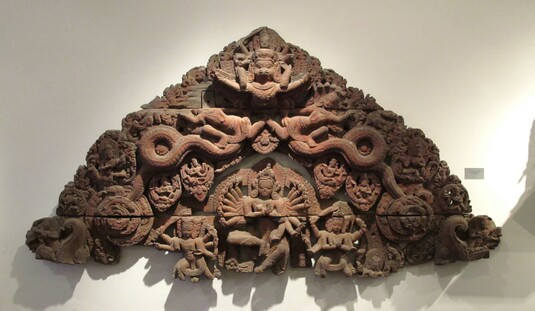
Item: Miscellaneous - Torana
| Origin Location | Nepal |
|---|---|
| Date Range | 1600 - 1699 |
| Lineages | Buddhist |
| Material | Wood |
| Collection | Private |
Classification: Object/Concept
Torana: carved from wood, depicting at the center a form of Avalokiteshvara Padmanarteshvara. Elaborate torana such as these are commonplace in Kathmandu, Nepal, and are found decorating temples both above the entrance ways and as window treatments. With this usage they are less a throne back and more intended and understood as a gateway, an auspicious gateway into a temple.
Padmanarteshvara is a form of Avalokiteshvara and literally means the Lord of the Lotus Dance. He is especially practiced by the Tibetans known as Sherpas inhabiting the Himalayan mountains on the border between Nepal and China (Tibet). The annual ritual celebrating Padmanarteshvara is called the Mani Rimdu and has been filmed and written about by many scholars over the last half century.
Torana sculpture and painted imagery in two-dimensional compositions generally represent three basic early ideas. The first (1) is representing a decorative vestibule where a religious sculpture would be placed, figurative or a stupa. The second (2) is a decorative gateway, an entrance for a temple or stupa complex, such as the example above. The third (3) is a throne back to decorate and frame the image of a Buddha, Bodhisattva or peaceful deity figure.
There is no actual definitive appearance, standards, or iconography for a torana. They can appear different in different geographic regions of India, Nepal, Kashmir, Afghanistan, Himalayas, Tibet, etc. The original toranas were architectural and regional in design, developing as the artistic traditions matured and changed.
In Tibetan and Himalayan Buddhism, over time, the ornately displayed throne-back, Torana, is known as the 'six ornament' design. The general shape is like an oval gate or frame, sometimes rectangular. On each side of the torana, at the bottom left and right are elephants. Supported above that are lions (or snow lions), a horse (often with the characteristics of other animals such as a lion, etc.). Above that is a small boy who sometimes holds a conch shell in one hand and supports a horizontal throne strut with the other. Above that is a makara (water creature). Above that is a naga - with a human upper torso and snake's tail for the bottom which extends upward. At the very top is a single garuda bird who bites down with the beak on the two extended tails of the two nagas from below, or bites down on a naga held in the outstretched arms. Sometimes there is an ornate silk canopy above the torana. It is not clear how the various elements of the torana are enumerated into the group of the 'six ornaments.' It is possible that the boy and the flying horse are grouped as one ornament.
Top Down:
Garuda
Nagas
Makaras (water monster)
Boys
Horses (sharabha, half lion)
Lions
Elephants
Aside from the Garuda at the top of the torana with only one representation each of the other figures are paired standing at the left and right of the throne. Click on the image of the painting at the right to see an example of how the Tibetan Buddhist 'Six Ornaments' of a torana are stacked. Look to the Torana Page for more examples.
Symbolically the 'six ornaments' have many meanings such "as the seven things to be eliminated on the path, the six perfections, the four gathering things, the strength of the ten powers, the stainless and the clear light." (Gateway to the Temple by Thubten Legshay Gyatsho. 1971, 1979. page 46).
Jeff Watt 9-2010
Buddhist Deity: Lokeshvara, Padmajala (Dancing) Page
Subject: Torana Main Page (Arch, Decorative Throne Back)





